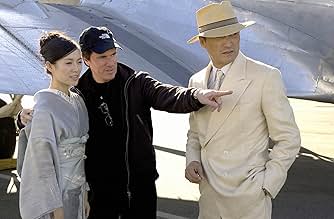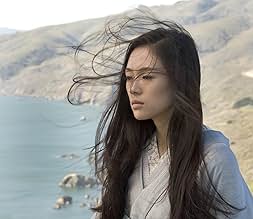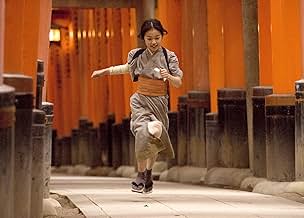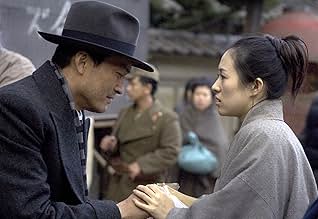Nitta Sayuri enthüllt, wie sie ihre Wurzeln in einem Fischerdorf hinter sich ließ und zu einer der berühmtesten Geisha Japans wurde.Nitta Sayuri enthüllt, wie sie ihre Wurzeln in einem Fischerdorf hinter sich ließ und zu einer der berühmtesten Geisha Japans wurde.Nitta Sayuri enthüllt, wie sie ihre Wurzeln in einem Fischerdorf hinter sich ließ und zu einer der berühmtesten Geisha Japans wurde.
- Regie
- Drehbuch
- Hauptbesetzung
- 3 Oscars gewonnen
- 32 Gewinne & 47 Nominierungen insgesamt
Empfohlene Bewertungen
personally, i don't know what everyone was so anxious about before viewing this movie. i had heard a lot of praise about the cinematography and the depth and emotion of the storyline. who cares if the actors were of different race? i know a lot of people will take offense to that, but being an Asian-American myself, it didn't bother me too much, since it wasn't what i thought of while watching the movie. who has time to think of different dialects and someone being Chinese when a beautiful story of the life of a geisha is being told.
i thought maybe the movie would not live up to the book, but i felt the adaptation was done well. although some of the casting could have been done better, i got chills from mother, angry at hatsumomo, and grew respect for the character of mameha, just as i had from the book. the movie did a fine job establishing the highly disciplined world of a geisha, a world where many sacrifices are to be made.
all in all, the movie was fantastic, and if people could just look beyond the issue of worrying about the nationality of a character who is supposed to be Japanese (and to me, its not a huge issue) I'm sure you will enjoy the movie.
i thought maybe the movie would not live up to the book, but i felt the adaptation was done well. although some of the casting could have been done better, i got chills from mother, angry at hatsumomo, and grew respect for the character of mameha, just as i had from the book. the movie did a fine job establishing the highly disciplined world of a geisha, a world where many sacrifices are to be made.
all in all, the movie was fantastic, and if people could just look beyond the issue of worrying about the nationality of a character who is supposed to be Japanese (and to me, its not a huge issue) I'm sure you will enjoy the movie.
As someone who read the book before watching the movie, I was pleased with the adaptation. The right parts were highlighted and felt the cuts made were necessary for length. The story is truly a tragically beautiful one, and the actors cast fit their characters. Great acting and some beautiful cinematography. Sayuri's dance scene was mesmerizing.
Can a group of American men and Chinese actresses render the world of a Japanese geisha? The answer is yes, with stunning beauty
and regrettable flaws.
Truth be told, this movie was not as bad as its trailer led me to expect it to be. It had a story to tell (although it crumbles in the end),images to show, and material to present. There were ample displays of exquisite beauty -- the trailing tails of silk kimonos, the subtle allure of hand gestures, and the captivating scene of kabuki dance theater ...
On the other hand, the American director was not able to pull the Japanese out of Chinese actresses. (This movie was so crowded by famous Chinese idols that I found myself inadvertently searching for Joan Chen among the cast.) To be fair, all three main actors (Gong Li in particular) show strong performances that made me sympathetic to Rob Marshall's choices. However, they remain utterly Chinese throughout this movie. The look and accent are not the only problems. They lacked the kind of extreme femininity and excessive felicity of the delicately mechanical gesture and movements of traditional Japanese ladies you see in custom dramas of Japanese production. (Michelle Yeoh seems to be the only one trying a little bit of those, but it did not quite work for some reason.)
So, let me re-address the question: Can a group of American men and Chinese actresses render the world of a geisha? The answer, I guess, really depends on what you are looking for. If you would like a little bit of delight from an aesthetically pleasing picture with a dubious authenticity and realism, this movie delivers it. I would not say Rob Marshall failed completely. Memoirs of a Geisha is not the first, nor the last, movie that subjects another culture to the crude lens of American exoticism. It definitely is not the worst one.
Truth be told, this movie was not as bad as its trailer led me to expect it to be. It had a story to tell (although it crumbles in the end),images to show, and material to present. There were ample displays of exquisite beauty -- the trailing tails of silk kimonos, the subtle allure of hand gestures, and the captivating scene of kabuki dance theater ...
On the other hand, the American director was not able to pull the Japanese out of Chinese actresses. (This movie was so crowded by famous Chinese idols that I found myself inadvertently searching for Joan Chen among the cast.) To be fair, all three main actors (Gong Li in particular) show strong performances that made me sympathetic to Rob Marshall's choices. However, they remain utterly Chinese throughout this movie. The look and accent are not the only problems. They lacked the kind of extreme femininity and excessive felicity of the delicately mechanical gesture and movements of traditional Japanese ladies you see in custom dramas of Japanese production. (Michelle Yeoh seems to be the only one trying a little bit of those, but it did not quite work for some reason.)
So, let me re-address the question: Can a group of American men and Chinese actresses render the world of a geisha? The answer, I guess, really depends on what you are looking for. If you would like a little bit of delight from an aesthetically pleasing picture with a dubious authenticity and realism, this movie delivers it. I would not say Rob Marshall failed completely. Memoirs of a Geisha is not the first, nor the last, movie that subjects another culture to the crude lens of American exoticism. It definitely is not the worst one.
In Japan of the 20's, the nine years old Chyio (Suzuka Ohgo) and her sister Satsu (Samantha Futerman) are sold by her fisherman father to a Geisha house in Miyako. Satsu is not accepted in the house and is sent to a brothel, and along the years, Satsu escapes from he brothel where she lived and the rebel Chyio is left alone, becoming a slave of a geisha. However, six years later, she learns how to become the geisha Sayuri (Ziyi Zhang) with the support of the successful Mameha (Michelle Yeoh), while fighting against the evil and jealousy of the wicked Hatsumomo (Gong Li). While still a child, Chyio falls in love with The Chairman (Ken Watanabe), and in the post-WWII, they meet each other, in a period o changes in Japan with the occupying American forces and the country completely destroyed.
The first half of "Memoirs of a Geisha" is a beautiful drama, telling the story of the country girl Chyio alone and adapting to a new life style in a house of geisha. Then, in the end of World War II, the screenplay becomes a soap-opera and the story becomes lesser and lesser attractive. However, the cinematography, the art direction and the costume design are amazing along the whole movie. But the cast speaking in English and keeping some Japanese words seems quite ridiculous for me. For such a careful production, this seems to be an unforgivable mistake. My vote is eight.
Title (Brazil): "Memórias de uma Gueixa" ("Memoirs of a Geisha")
The first half of "Memoirs of a Geisha" is a beautiful drama, telling the story of the country girl Chyio alone and adapting to a new life style in a house of geisha. Then, in the end of World War II, the screenplay becomes a soap-opera and the story becomes lesser and lesser attractive. However, the cinematography, the art direction and the costume design are amazing along the whole movie. But the cast speaking in English and keeping some Japanese words seems quite ridiculous for me. For such a careful production, this seems to be an unforgivable mistake. My vote is eight.
Title (Brazil): "Memórias de uma Gueixa" ("Memoirs of a Geisha")
Why there is so much polarity with the audiences of Rob Marshall's cinematic adaptation of Arthur Golden's exquisite novel MEMOIRS OF A GEISHA is puzzling. Even in the theater there were those who left halfway through - reason unknown. Despite disagreements on the casting techniques and on the emphasis changes between the book and the film, MEMOIRS remains one of the most visually arresting, genteel films of the year. That it comes across as somewhat of an epic soap opera is no one's fault but the writers. And what is so wrong with an old-fashioned soap opera of a story afterall? The opening scene of the turbulent sea and heavy rain that accompany the silent selling of two poor sisters to a merchant planning to place the girls in houses in Osaka gives an indication of the importance of water in this story. The sisters are delivered to a house of geishas and only one is selected by the hard madam. Through years of suffering and anguish the chosen one becomes a geisha, finds comfort from her childhood of poverty, gains loving mentoring by a top geisha, becomes the most sought after geisha in Osaka, finds her love, endures WW II and eventually returns to her dreams. The interplay between the girl and the various members of the geisha training and bartering complex add flavor and conflict that keep the story flowing.
The three principal actresses - Ziyi Zhang, Michelle Yeoh, and Gong Li carry the film well. The large cast includes favorite actors Ken Watanabe and Mako. The settings are splendid, the special effects such as the cherry blossoms, the autumnal reunion of Zhang and Watanabe, Zhang's spellbinding dance - all are brilliant. John Williams' musical score blends the best of Japanese folk music with contemporary writing and is greatly abetted by the talent of Yo-Yo Ma and Itzak Perlman.
Part of the brilliance of Golden's novel was the meticulous explanation of the myriad details of geisha training and demeanor and makeup and tradition, and while the film version touches on these, the bulk of them are passed over. For this viewer there is a problem with understanding the dialogue due to the enunciation by the actors and the covering of much of the dialogue with ambient music. But that is a minor complaint. In all, MEMOIRS OF A GEISHA is an enormously beautiful and affecting film, one that multiple viewings will no doubt enhance the viewers' appreciation. Recommended. Grady Harp, February 06
The three principal actresses - Ziyi Zhang, Michelle Yeoh, and Gong Li carry the film well. The large cast includes favorite actors Ken Watanabe and Mako. The settings are splendid, the special effects such as the cherry blossoms, the autumnal reunion of Zhang and Watanabe, Zhang's spellbinding dance - all are brilliant. John Williams' musical score blends the best of Japanese folk music with contemporary writing and is greatly abetted by the talent of Yo-Yo Ma and Itzak Perlman.
Part of the brilliance of Golden's novel was the meticulous explanation of the myriad details of geisha training and demeanor and makeup and tradition, and while the film version touches on these, the bulk of them are passed over. For this viewer there is a problem with understanding the dialogue due to the enunciation by the actors and the covering of much of the dialogue with ambient music. But that is a minor complaint. In all, MEMOIRS OF A GEISHA is an enormously beautiful and affecting film, one that multiple viewings will no doubt enhance the viewers' appreciation. Recommended. Grady Harp, February 06
WUSSTEST DU SCHON:
- WissenswertesThe elements of nature are a running theme through this film and each of the four main Geisha have an elemental character. Sayuri is water, Mameha is wind, Pumpkin is wood (the equivalent of earth) and Hatsumomo is fire.
- PatzerWhen Hatsumomo and Pumpkin are leaving on the night of Pumpkin's debut, neither Mother nor Auntie spark flint on their backs. A Geisha would never leave her okiya without this act being performed as it was believed it brought good luck.
- Crazy CreditsNo studio logos are shown at the beginning; they appear shortened after the end credits and are accompanied by the film's score.
- VerbindungenFeatured in The 63rd Annual Golden Globe Awards 2006 (2006)
- SoundtracksAnata No Mono Yo
Written by Takao Saeki and Kôka Sassa
Performed by Noriko Awaya
Courtesy of Columbia Music Entertainment, Inc.
Top-Auswahl
Melde dich zum Bewerten an und greife auf die Watchlist für personalisierte Empfehlungen zu.
Details
- Erscheinungsdatum
- Herkunftsland
- Offizieller Standort
- Sprachen
- Auch bekannt als
- Memorias de una geisha
- Drehorte
- California State Railroad Museum - 111 I Street, Sacramento, Kalifornien, USA(interiors: railroad station)
- Produktionsfirmen
- Weitere beteiligte Unternehmen bei IMDbPro anzeigen
Box Office
- Budget
- 85.000.000 $ (geschätzt)
- Bruttoertrag in den USA und Kanada
- 57.490.508 $
- Eröffnungswochenende in den USA und in Kanada
- 682.504 $
- 11. Dez. 2005
- Weltweiter Bruttoertrag
- 162.242.962 $
- Laufzeit2 Stunden 25 Minuten
- Farbe
- Sound-Mix
- Seitenverhältnis
- 2.39 : 1
Zu dieser Seite beitragen
Bearbeitung vorschlagen oder fehlenden Inhalt hinzufügen




























